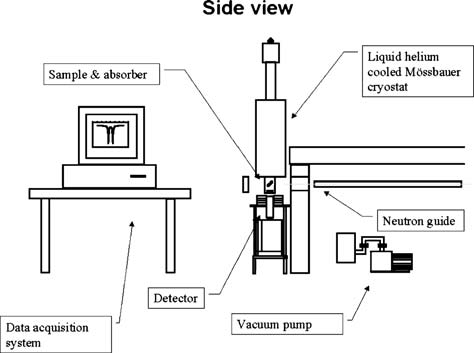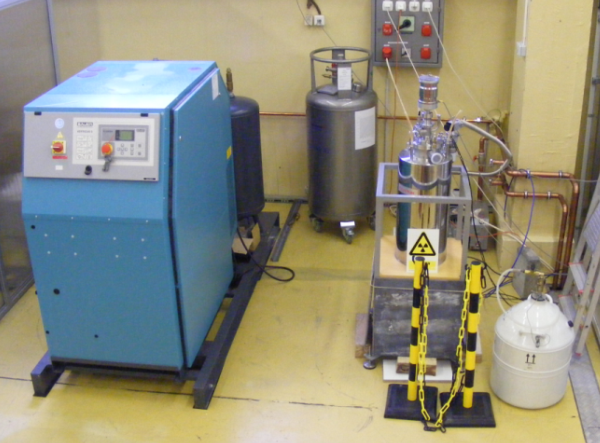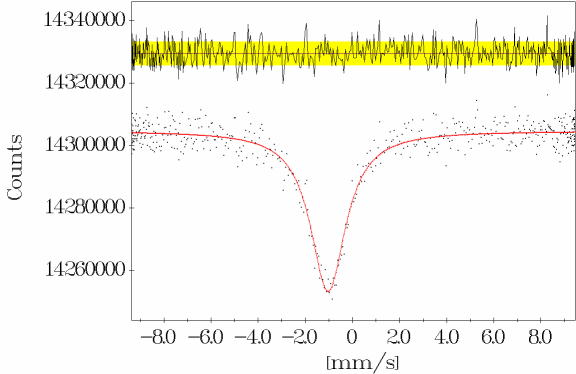In-beam Mössbauer spectroscopy
Introduction
In 2001, a
liquid hydrogen containing cold neutron source was installed
at the Budapest Research Reactor. Part of the neutron guide system was
also reconstructed
at the same time. Due to these modifications the neutron flux increased
more than an order of magnitude. These made possible to widen our
experimental possibilities at the Budapest Neutron Centre (BNC). From a
number of possibilities the in-beam Mössbauer spectroscopy has been
selected and the realization is in progress.
The instrument can be used on-line, but during reactor shutdown, activated short lived Mössbauer sources will also be utilized. During the on-line operation a beam of guided cold neutrons produce the Mössbauer transitions continuously. The cold neutron flux, transmitted by a focused supermirror guide is measured to be about 109 n cm−2 s−1 at the target position. The beam shutter is installed at the beginning of the 7 m long guide section to avoid the high radiation caused by the closed beam shutter. The experimental area is shielded by concrete walls from the rest of the guide system on both at the entering and at the leaving sides. Near the guide end a collimator system made of lead and 6Li-enriched polyethylene is placed in the hole of the shielding concrete walls to minimize the unwanted radiations. The diameter of the beam, passing through this collimator system, at the target position is about 1×1 cm2. The neutron beam enters through a thin vertical window (made of Mylar and beryllium) into the cryostat and leaves on its opposite side. The cryostat can be operated in the 3–360 K temperature range with liquid helium or nitrogen cooling. The maximum areas of the Mössbauer source and absorber are about 1 cm2 thus the available maximum source strength is about 1 GBq. The sample holder is fixed to the end of a steel tube, which holds the moving rod mechanics as well as the absorber at its bottom.
The Mössbauer transducer (Wissel MVT 1,000) is fitted to the top of the specifically modified cryostat (Konti-IT-Cryostat-Spektro-He product of CryoVac) and an aluminum moving rod connected to the transducer moves the Mössbauer source up and down in the beam.

Figure 1. Schematic drawing of the in-beam Mössbauer equipment.
First experiments on 197Au
Our first experiments were conducted on gold in off-line mode. The Mössbauer-active isotope of gold, 197Au, is also the naturally occurring form, and has 100% abundance. The excited state of 197Au is populated directly by β–-decay of 197Pt (Fig. 2) which is readily obtained by neutron irradiation of enriched platinum by the reaction 196Pt(n,γ)197Pt.
57Fe |
197Au | |
|
Eγ, keV |
14.41 |
77.34 |
|
Γ, mm/s |
0.192 |
1.87 |
|
Iα |
-1/2 |
+3/2 |
|
Iγ |
-3/2 |
+1/2 |
|
a, % |
2.17 |
100 |
|
T1/2, ns |
99.3 |
1.892 |
|
α |
8.17 |
4 |
|
Er, eV·10-2 |
0.195 |
1.63 |
|
σ, cm2·10-18 |
2.57 |
0.041 |
|
ΔR/R, 10-4 |
-14 |
+3 |
Table 1. Comparison of 57Fe and 197Au Mössbauer-active nuclei.

Figure 2. Nuclear decay scheme of a 197Pt source.
We irradiated a 100mg, 50µm thick and 1 cm in diameter platinum foil 94.57% enriched in 196Pt with a flux of 6.13×1013ncm-2s-1 for 12 hours and subsequently obtained a 1GBq 197Pt source, which we were able to use for about a week. This source was placed in the nuclear reactor in a quartz tube which was wrapped in aluminum foil. After a 6 hour rest it was placed in the cryostat along with a 25µm thick gold foil as an absorber. 197Au Mössbauer spectroscopy does not necessarily require liquid He temperatures hence both (He and N2) tanks were filled with liquid nitrogen and the sample and source were cooled down to 80 K. The operating temperature was achieved through the use of a heat exchanger mounted on the bottom of the experimental chamber. With the precise regulation of the liquid flow with a needle valve the cryostat was brought to a thermal equilibrium just below 80K after which the temperature was stabilized at 80K with a Cryovac TIC 304-MA temperature measuring and control unit. The liquid nitrogen consumption after reaching and stabilizing the operating temperature was about 0.2l/h. The isolation vacuum of the cryostat was obtained with a TSH 071 E turbomolecular drag pumping station from Pfeiffer Vacuum with an end pressure of about 10-7 mbar. The photo of the equipment used in this offline Mössbauer experiment is displayed on Fig. 3.

Figure 3. The equipment used in the offline Mössbauer experiment.
Liquid He cryostat (right) and high pressure compressor for He recirculation (left)
The pulse-height spectrum of the 197Pt source is given in Fig.4. We were able to easily discriminate the 77.4keV 197Au peak from the nonresonant background radiation. The enriched platinum foil contained 0.42% of 198Pt which contributed two minor peaks of 199Au.

Figure 4. Pulse-height spectrum of a 197Pt source produced by irradiation of 94.57% enriched in 196Pt foil.
The Mössbauer spectrum of the 25µm thick gold absorber at 80 K can be seen on Fig.4. The spectrum was calibrated with a subsequently measured α-Fe spectrum.

Figure 5. Mössbauer spectrum of a 25µm thick gold absorber at 80 K.
Conclusions
The in-beam Mössbauer facility will become a proper tool for the investigation of the Mössbauer-effect on a great variety of nuclides. A broad range of applications in structural chemistry is also foreseen.

